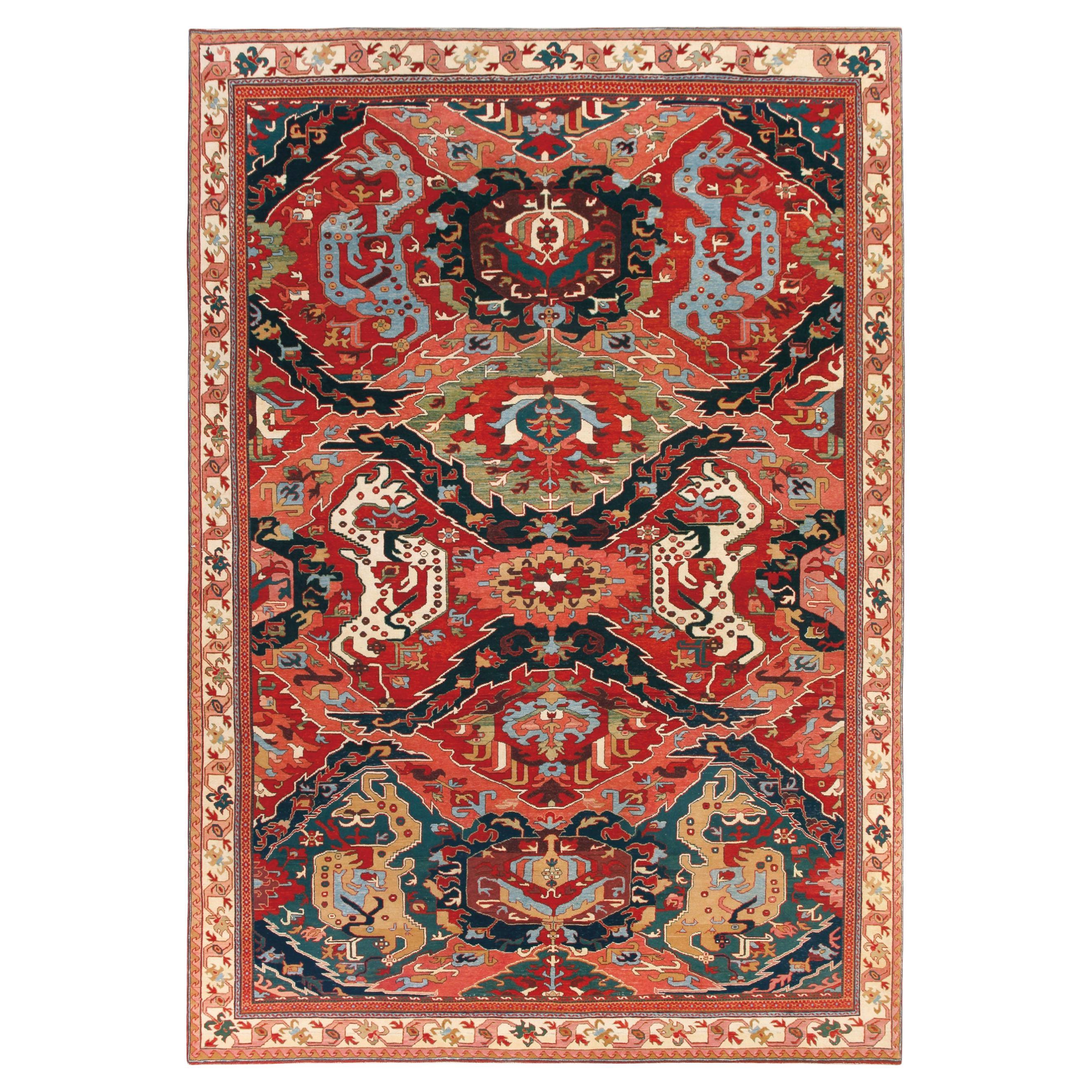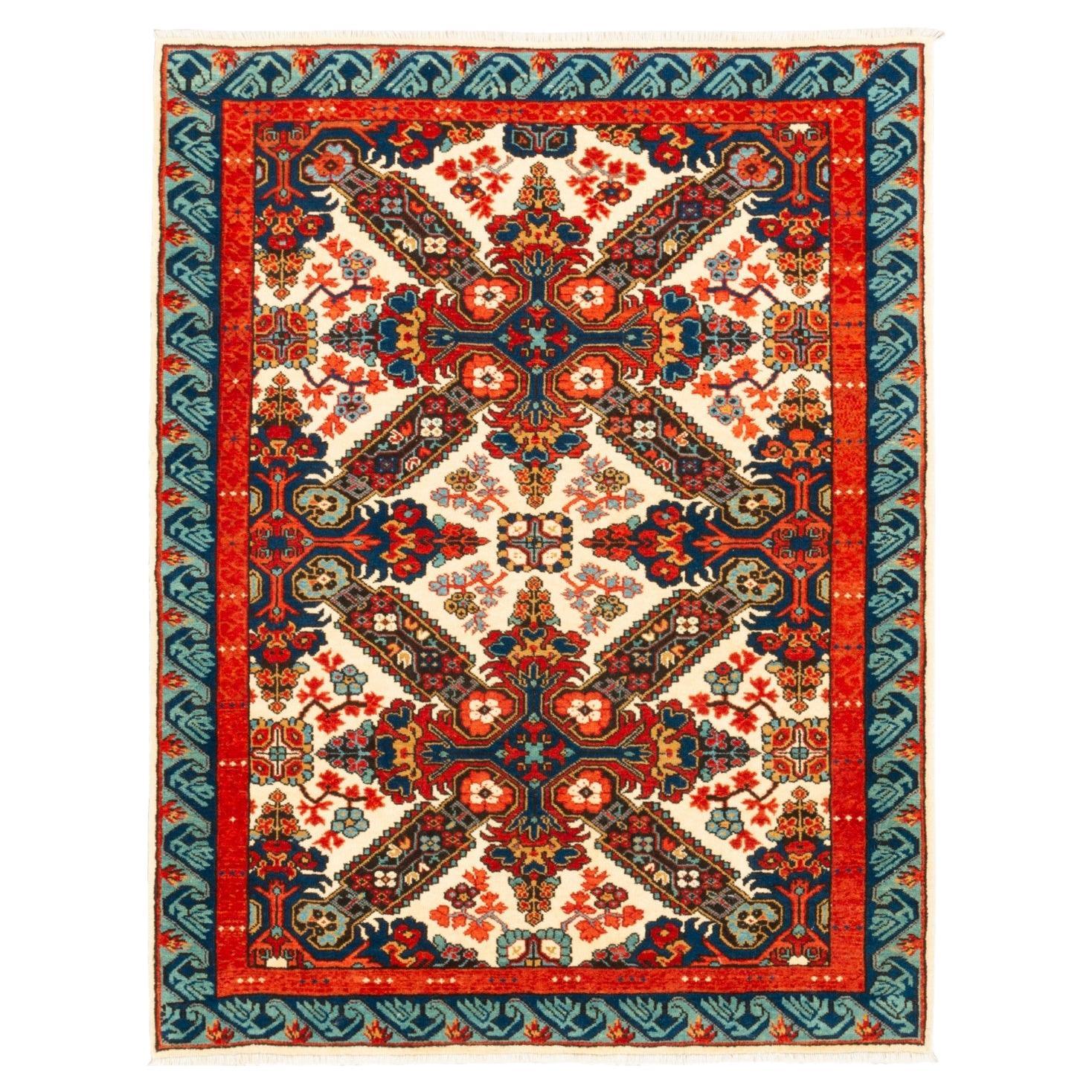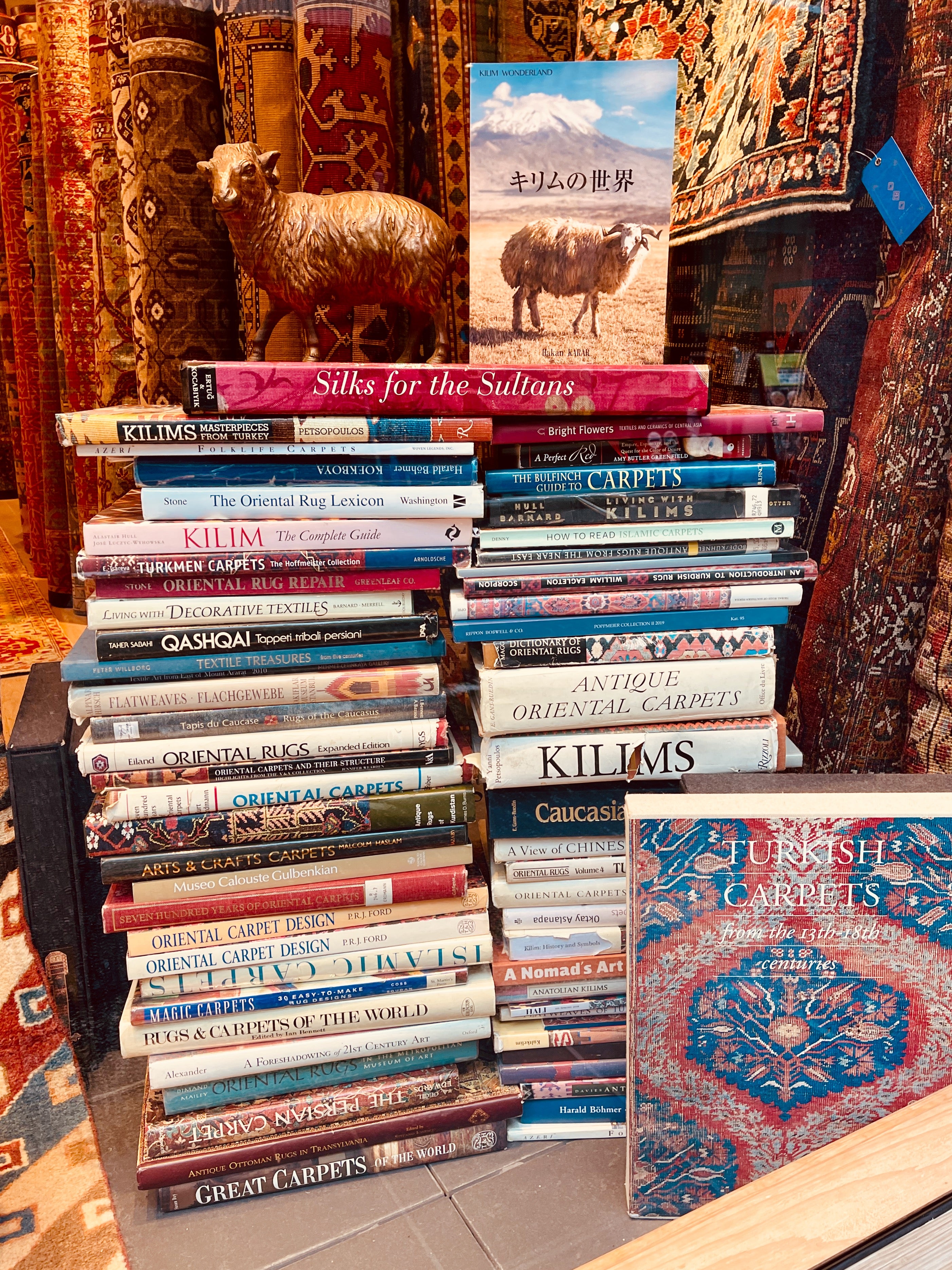Items Similar to Ararat Rugs Dragon Rug, Antique Caucasus Museum Revival Carpet, Natural Dyed
Want more images or videos?
Request additional images or videos from the seller
1 of 6
Ararat Rugs Dragon Rug, Antique Caucasus Museum Revival Carpet, Natural Dyed
About the Item
The source of the carpet comes from the book Hali Magazine 1993 Issue 67, pg.93 and Hali Magazine 1992 Issue 61, pg.61. Peter Bausback, Mannheim, described it on the occasion of his exhibition at the Textura 1992 in Maastricht (see also HALI, Issue 67, 1993) as follows: ‘In my opinion, this is an excellent specimen of this group, to which in quality, color, and expression no comparable piece is found’. The carpet was probably made in the 17th century in the Caucasus (in HALI 61, February 1992, the carpet is shown on p. 61 but is carefully conservatively dated with the 18th century) and resembles the early dragon carpets; it is much more expressive due to the powerful design of both the border and the field with the filling ornaments like people and animals. Very expressive are also the living dragon ornaments as the main motif of the carpet whose center forms a grimace-like element. The carpet comes from a noble Central European house and suspected that it once came to Europe via Transylvania. Unlike most of the other surviving dragon carpets, which come from manufactories, it is of undoubtedly village origin. Only in the Vakiflar Museum in Istanbul, there is such a dragon village rug shown, corresponding in size. The design of this rug is interpreted with a series of borders and our designers choose soft colors for this rug.
Color summary: 8 colors in total, most used 4 colors are;
Bistre Brown 411 (Pomegranate – Madder Root)
Emerald Green 407 (Chamomile – Indigo)
Natural Wool Color 320 (No Dye)
Khaki 413 (Dyer’s Weed)
Group: Caucasian Rugs Family
Area: Caucasus
Material of Pile: Natural Dyed Hand-spun Wool
Material Warp / Weft: Wool on Wool
Structure: Symmetrical knot
Knots Density: 36x29
Production Place: Wast Anatolia – Manisa Province
Stock Location: Tokyo
Size (EU): 247 x 204cm
Size (US): 8'1" x 6'8"
Area (EU): 5m²
Area (US): 54.2ft².
- Creator:Ararat Rugs (Manufacturer)
- Dimensions:Width: 80.32 in (204 cm)Length: 97.25 in (247 cm)
- Style:Revival (In the Style Of)
- Materials and Techniques:
- Place of Origin:
- Period:
- Date of Manufacture:2021
- Production Type:New & Custom(One of a Kind)
- Estimated Production Time:Available Now
- Condition:
- Seller Location:Tokyo, JP
- Reference Number:1stDibs: LU8206233203482
ARARAT RUGS
We know and believe that the geography we come from, our past, and our lifestyle are the most important bond between us to carry the oriental carpet art and culture to the next generations along with our core values in our ongoing growth journey.
We are aware that the way to achieve this goal and carry this priceless art and culture to the future depends on a lot of work with all our people every day while adhering to our core values.
For us, art is meaningful in the sense that it brings together various cultures around the world. It is an honor for us that oriental carpet art and culture have been instrumental in this for centuries and that we are a part of this business.
We are tirelessly keeping an eye on auction house information around the world about carpets. New York's Metropolitan, London's Victoria & Albert Museums, and other famous art museums, as well as small specialized museums that house private collections, and books about oriental carpets to collect information on outstanding carpet designs and patterns from around the world. It's our Self-improving and Self-developing culture.
As Turkish Culture of Hospitality, the Kurdish Culture of Generosity, and as Japanese Culture of Business Punctuality; are the most important values that this multicultural background has taught and bequeathed to us. It is essential and valuable for us that you feel this feeling not only by looking at our oriental carpets but from the moment you contact us.
About the Seller
5.0
Gold Seller
These expertly vetted sellers are highly rated and consistently exceed customer expectations.
Established in 1970
1stDibs seller since 2023
12 sales on 1stDibs
Typical response time: <1 hour
- ShippingRetrieving quote...Ships From: Tokyo, Japan
- Return PolicyA return for this item may be initiated within 7 days of delivery.
More From This SellerView All
- Ararat Rugs Dragon Rug, Antique Caucasus Museum Revival Carpet, Natural DyedBy Ararat RugsLocated in Tokyo, JPThe source of the rug comes from the book Caucasian Carpets, E. Gans-Reudin, Thames and Hudson, Switzerland 1986, pg.37. This luxurious and varied work is known as the Cassirer drago...Category
21st Century and Contemporary Turkish Revival Caucasian Rugs
MaterialsWool, Natural Fiber, Organic Material
- Ararat Rugs Dragon Rug, Antique Caucasus Museum Revival Carpet, Natural DyedBy Ararat RugsLocated in Tokyo, JPThere has long been a fascination with the symbolism of the dragon and its depiction in carpet weavings. The design of ‘Dragon’ carpets consists of a field pattern composed of different colored overlaid lattices formed of pointed, serrated leaves creating intersecting lozenges, which alternately contain palmettes and are flanked by confronting stylized dragons, birds, or animal figures. The most archaic of the ‘Dragon’ carpets include dragon motifs with birds and running animals relatively naturalistically drawn, which stand either alone or in confronting pairs facing a tree. The Graf carpet, originally found in a Damascene mosque, now in the Islamiches Museum, Berlin, is considered to be the oldest example of this type, see Serare Yetkin, Early Caucasian Carpets in Turkey, Vol. II, London, 1978, p.8, fig.118. Yetkin defines four types of ‘Dragon’ carpet: ‘Archaic’, ‘Four-Dragon’, ‘Dragon-and-Phoenix’ and as a further combined development of the latter, the ‘Two-Dragon’ style, of which the present carpet falls into the ‘Dragon-and-Phoenix group along with other examples, some of which include two fragments, one in the Museum fur Kunst und Gerwerbe, Hamburg; another in the Christian Museum, Esztergom, Hungary, a complete carpet in the Kier collection; an incomplete example in the Textile Museum, Washington, D.C; the ‘Cassirer’ Dragon carpet in the Thyssen-Bornemisza collection, Lugano; the Ali Pasa Mosque carpet in Tokat, and a further example in the Vakiflar Hali Museum, Istanbul (S. Yetkin, op. cit. pp.16-20). It has been suggested that the earliest examples of the Caucasian ‘Dragon’ carpets...Category
21st Century and Contemporary Caucasian Revival Caucasian Rugs
MaterialsWool, Natural Fiber, Organic Material
- Ararat Rugs Dragon Rug, Antique Caucasus Museum Revival Carpet, Natural DyedBy Ararat RugsLocated in Tokyo, JPThe source of the rug comes from the book Orient Star – A Carpet Collection, E. Heinrich Kirchheim, Hali Publications Ltd, 1993 nr.57. There has long been a fascination with the symbolism of the dragon and its depiction in carpet weavings. The design of ‘Dragon’ carpets consists of a field pattern composed of different colored overlaid lattices formed of pointed, serrated leaves creating intersecting lozenges, which alternately contain palmettes and are flanked by confronting stylized dragons, birds, or animal figures. The most archaic of the ‘Dragon’ carpets include dragon motifs with birds and running animals relatively naturalistically drawn, which stand either alone or in confronting pairs facing a tree. The Graf carpet, originally found in a Damascene mosque, now in the Islamiches Museum, Berlin, is considered to be the oldest example of this type, see Serare Yetkin, Early Caucasian Carpets in Turkey, Vol. II, London, 1978, p.8, fig.118. Yetkin defines four types of ‘Dragon’ carpet: ‘Archaic’, ‘Four-Dragon’, ‘Dragon-and-Phoenix’ and as a further combined development of the latter, the ‘Two-Dragon’ style, of which the present carpet falls into the ‘Dragon-and-Phoenix group along with other examples, some of which include two fragments, one in the Museum fur Kunst und Gerwerbe, Hamburg; another in the Christian Museum, Esztergom, Hungary, a complete carpet in the Kier collection; an incomplete example in the Textile Museum, Washington, D.C; the ‘Cassirer’ Dragon carpet in the Thyssen-Bornemisza collection, Lugano; the Ali Pasa Mosque carpet in Tokat, and a further example in the Vakiflar Hali Museum, Istanbul (S. Yetkin, op. cit. pp.16-20). It has been suggested that the earliest examples of the Caucasian ‘Dragon’ carpets...Category
21st Century and Contemporary Turkish Revival Caucasian Rugs
MaterialsWool, Natural Fiber, Organic Material
- Ararat Rugs Dragon Rug, Antique Caucasus Museum Revival Carpet, Natural DyedBy Ararat RugsLocated in Tokyo, JPThe source of the rug comes from the book Caucasian Carpets, E. Gans-Reudin, Thames and Hudson, Switzerland 1986, pg.37. This luxurious and varied work is known as the Cassirer drago...Category
21st Century and Contemporary Turkish Revival Caucasian Rugs
MaterialsWool, Natural Fiber, Organic Material
- Ararat Rugs Konagkend Kuba Rug, Antique Caucasian Revival Carpet, Natural DyedBy Ararat RugsLocated in Tokyo, JPThe source of the rug comes from the book Oriental Rugs Volume 1 Caucasian, Ian Bennett, Oriental Textile Press, Aberdeen 1993, nr.332. This is a sp...Category
21st Century and Contemporary Turkish Revival Caucasian Rugs
MaterialsWool, Natural Fiber, Organic Material
- Ararat Rugs Seichur Kuba Rug Caucasian Antique Kazak Revival Carpet Natural DyedBy Ararat RugsLocated in Tokyo, JPThe source of the rug comes from the book Tapis du Caucase - Rugs of the Caucasus, Ian Bennett & Aziz Bassoul, The Nicholas Sursock Museum, Beirut, Lebanon 2003, nr.90 and Oriental R...Category
21st Century and Contemporary Turkish Revival Caucasian Rugs
MaterialsWool, Organic Material, Natural Fiber
You May Also Like
- Antique Karachov Kazak Carpet, Handmade Wool, Pale Blue, Rust, Ivory, GeometricLocated in Port Washington, NYKarachov Kazak: A quite famous and seldom-found design type, usually attributed to the Armenian weavers of the high Caucasus Mountains. The best of the ...Category
Antique Late 19th Century Russian Kazak Caucasian Rugs
MaterialsWool
- Antique Kazak Carpet, Handmade Wool, Rust, Ivory, Navy, Light Blue and GeometricLocated in Port Washington, NYThe Rust field scattered with minor stylized flower heads, hooked panels and minute cross-motifs around a column of ivory octagonal panels containing radiating flower heads and minut...Category
Antique Late 19th Century Russian Kazak Caucasian Rugs
MaterialsWool
- Antique Kazak Carpet, Handmade Wool, Rust, Ivory, Navy, Light Blue and GoldLocated in Port Washington, NYThe Rust field scattered with minor stylized flower heads, hooked panels and minute cross-motifs around a column of ivory octagonal panels containing radiating flower heads and minut...Category
Antique Late 19th Century Russian Kazak Caucasian Rugs
MaterialsWool
- Antique Caucasian Rug - Rare Caucasian Carpet, Caucasus Rug, Antique RugLocated in Sultanahmet, 34Rare Caucasian Rug Caucasus Rug Size: 176×224 cm This wonderful rug is a formerly unpublished addition to a small and rare group of blue-ground Caucasian rugs whose design is dominated by a prominent decahedral gabled ivory medallion. The overall pattern echoes that of a group of earlier 17th and 18th century north west Persian carpets, whose designs were based upon the Persian garden plan known as the “Four Gardens” or Chahar Bagh (M.S.Dimand & J. Mailey, Oriental Rugs in the Metropolitan Museum of Art, New York, 1973, p.84, fig.116). The smaller lozenges that extend above and below the central medallion on the present lot, are linked by a narrow vertical channel which represents the streams and ornamental pools that feed the flowering trees and shrubs on either side. The once eight-pointed medallion, that is an archaic form found in early Anatolian and Caucasian rugs, and which continues to be used throughout the nineteenth century in Fachralo rugs...Category
Antique 19th Century Caucasian Caucasian Rugs
MaterialsWool
- 19th Century Antique Shirvan Caucasian Pictorial RugLocated in New York, NYAN intermediate square size antique Caucasian shirvan pictorial rug circa 1875. Measures: 4'1" x 4'9''.Category
Antique 19th Century Russian Campaign Caucasian Rugs
MaterialsWool
- Antique Caucas Daghestan Hand Knotted Wool Rug, circa 1880Located in Barcelona, BarcelonaAntique rug from Caucas Daghestan, circa 1880. Hand knotted wool with some restaurations Measures: 93 x 157.Category
Antique 1880s Turkestan Kazak Caucasian Rugs
MaterialsWool






